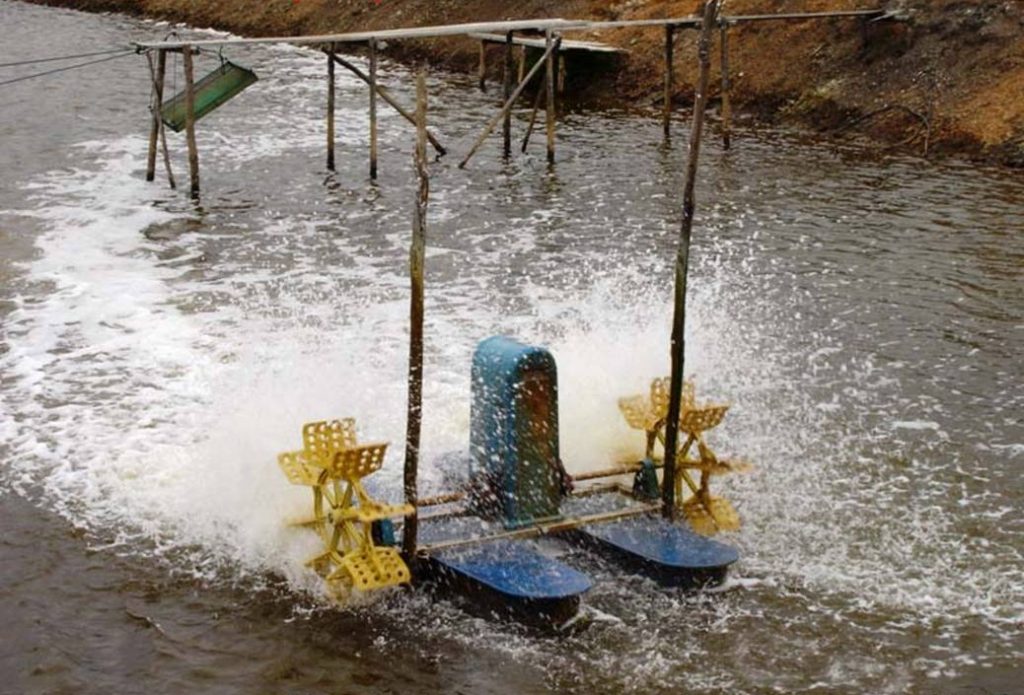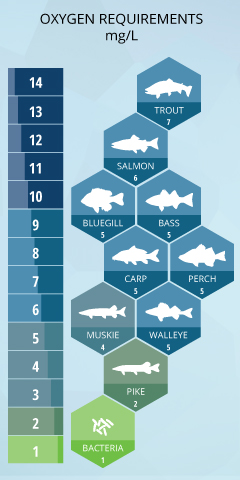Top 9 Questions about Dissolved Oxygen and Aquaculture
One: What is it?
Dissolved oxygen is just what it sounds like: it is the oxygen dissolved in water. Fish and shrimp breathe underwater, but they still breathe oxygen. Too little dissolved oxygen means more stress for fish and shrimp. Too little for too long could mean death. To keep your aquaculture animals healthy, you have to let them breathe.
Two: What affects dissolved oxygen levels in water?
Dissolved oxygen levels can change for any number of reasons and do so throughout the day.
In aquaculture, the biggest factor driving down dissolved oxygen levels are the animals you’re raising. As fish or shrimp breathe, they remove oxygen from the water and add carbon dioxide, just like people do on land. On land, trees and other plants take the carbon dioxide we produce and turn it back into oxygen. In an aquatic system, algae do the same. A system of all fish, no algae (or other plants), would quickly become a system with little to no dissolved oxygen.
Other factors that impact the dissolved oxygen levels in an aquaculture pond is the exchange of oxygen at the surface, where the water meets the air. Because nature loves equilibrium, if oxygen levels are lower in the water than in the air, oxygen will move from the air to the water. If levels are higher in the water, oxygen will move to the air. This effect is relatively small, but larger on windy days.
Dissolved oxygen levels can also be affected manually. Techniques like aeration can increase dissolved oxygen levels by passing air through the water. It can also help stir the water, which can evenly redistribute and mix water with varying oxygen levels. Differences in oxygen levels commonly occur between near-surface and deep water. Aerating water can evenly mix oxygen-poor (hypoxic) and oxygen-rich water. This can eliminate hypoxic zones within a pond.
In emergency situations, substances like hydrogen peroxide can be used to raise dissolved oxygen levels in aquaculture ponds.

An aerator in an aquaculture pond in India. (Source: Wikimedia, Lupo)
Three: How do I measure it?
The simplest and easiest way to measure dissolved oxygen is a dissolved oxygen sensor. A dissolved oxygen sensor can quickly alert you to issues before they become a problem, keeping you from stressed or dead fish.
Four: What can go wrong?
The most extreme and permanent downside to low dissolved oxygen is mortality—fish death. But, dissolved oxygen does more for fish than keep them alive. It can help them thrive.
Research by Dr. Eugene Torrans showed that while catfish can survive dissolved oxygen levels at 1.0 parts per million (ppm), at levels of 3.0 ppm, the fish ate and grew twice as fast.
While different fish can tolerate different levels of dissolved oxygen, low oxygen is never a good thing. Fish in low oxygen water will lose their appetite and exhibit low energy. They become more susceptible to disease, inefficiently digest their food and grow slowly.
Five: How can I address problems with dissolved oxygen?
The first step to combating low dissolved oxygen is measuring it. It’s important to measure dissolved oxygen regularly to understand the daily fluctuations within your ponds. Understanding those fluctuations and identifying trends toward low dissolved oxygen can help you predict when dangerous low oxygen will occur. Taking preemptive action is always best.
If low dissolved oxygen happens, there are steps you can take. Ramping up or adding additional aeration to your ponds can help evenly distribute high oxygen water and get additional oxygen into the water. Mixing the water in other ways, like spraying water across the top of your pond, using a pump or other mechanical mixer, or swapping oxygen-poor water out for oxygen-rich water can help boost your dissolved oxygen levels.
Also, because dead plants and animals use up oxygen as they decompose, keeping your ponds relatively clear of dead organic matter keeps oxygen from being used for something other than growing your fish.
Six: What concerns should I have if I’m farming a pond?
Because aquaculture ponds are closed systems with only the resources you provide, it’s imperative you keep a close eye on dissolved oxygen levels. Because fish won’t be able to seek out oxygen-rich waters elsewhere (though they may move up or down the water column within a pond to seek out oxygen), it is vital they have a reliable, steady supply of oxygen available.

Knowing the oxygen requirement is important for managing fish health in aquaculture. (Credit: Fondriest)
Seven: What role do plankton play?
Dr. Claude Boyd, in the Global Aquaculture Advocate, writes that phytoplankton and algae, as the most important producer of oxygen in an aquaculture system, have a major effect on how much dissolved oxygen is available.
Phytoplankton create oxygen through photosynthesis, a process that requires the sun. This means that oxygen levels will rise throughout the day, but fall during the night. After the sun sets, photosynthesis stops—no more oxygen is produced—but respiration by aquaculture fish continues—oxygen is used up. This creates a natural daily cycle, with dissolved oxygen peaking in the daytime and reaching their lowest points just before the photosynthesis starts again in the early morning.
The amount of algae in a pond can affect the amount of oxygen at different depths throughout the pond as well.
Photosynthesis requires light. If a thick layer of algae grows on the top of a pond, it blocks light from deeper water and restricts photosynthesis—and therefore oxygen production—at that level. This could result in hypoxic water at deeper levels and require some sort of intervention.
Eight: What is a dissolved oxygen budget?
A dissolved oxygen budget is a tool that accounts for all the oxygen that enters a pond and all that gets used up or escapes. One formula for calculating dissolved oxygen gained or lost in pond water over time reads like this: the amount of oxygen created through photosynthesis minus the amount used by your fish and the amount lost to reactions with the pond’s water and mud. Then, add or subtract the amount gained or lost to the air, depending on the amount available in the water. Or, think of it like this:
Photosynthesis – respiration by fish – oxygen lost to water and mud ± oxygen gained or lost to the air.
Plugging the numbers into this equation takes some work and reliance on researchers who have calculated the amount of oxygen produced by plants or used by fish. We’ll discuss it more in depth in future posts. At this point, understand that if you’re taking more oxygen out than is being generated, you’re headed for trouble sooner or later.
Nine: What do I need to know to get started?
Now you’ve got the basic understanding of dissolved oxygen’s role in aquaculture systems, how to monitor it and how to address low dissolved oxygen. There’s plenty more to read—coming soon to this blog and around the web.
But if you’re itching to get going, the best thing you can do is get yourself a dissolved oxygen sensor and start tracking your levels. Your fish and your bottom line will thank you!
Top image: Fish at the surface of an aquaculture pond can be a sign of depleted dissolved oxygen.

0 comments